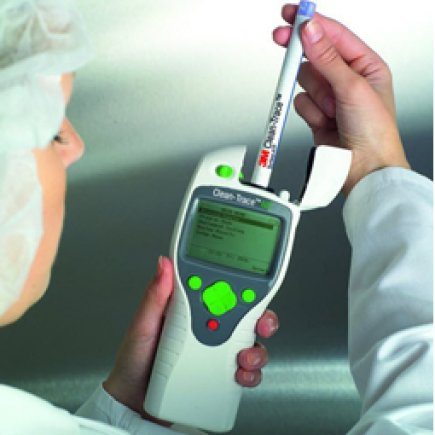First responders occasionally come across suspicious powders, requiring them to have technology on hand to screen samples and identify whether or not they are a chemical or biological agent.
Current technology performs a test to determine whether or not protein exists on the sample, an indication that the sample is live, or active. With this technology, specificity is low, false positives are common and the cost is very high: one test costs $26.
Researchers at the U.S. Army Edgewood Chemical Biological Center, or ECBC, are seeking alternate technology that is more effective and lower in cost. Originally funded by Section 219 funds, an ECBC effort designed to encourage innovative applied research, with additional funding from the Department of Homeland Security, the team evaluated existing technology to find a device that was close to field ready and determine what it would take to get it into the hands of a Soldier or a first responder.
The ECBC team evaluated several pre-screening technologies and found that while many could be useful for detecting a biological threat, ongoing issues with low specificity and false positives require additional costly research to determine an accurate diagnosis. During their research of existing technology, ECBC scientists came across a Cara Technology Limited Report (report 30606) which discussed the use of adenosine triphosphate-based technology to look for contamination on food surfaces.
Adenosine triphosphate, or ATP, is one of the main providers of energy to cells, and every reproducible organism has it. Historically, it was thought that spores do not have traceable amounts of ATP on their surface, but recent findings have indicated otherwise.
“This is exciting because it gives us a new avenue to research technologies that can screen suspicious powders much more effectively than what’s currently on the market for first responders,” said James Wright, a chemist with ECBC’s BioSciences Division. “A lot of assumptions were made 50 years ago that aren’t holding up. We’re finding now that we can screen at several orders of magnitude lower than previously thought.”
One of the systems the team chose to evaluate is the 3M Clean Trace Surface ATP technology, which meets the criteria they were looking for: Simple, compact and cost-efficient. Another key component is that the start-up costs are comparable to that of the current technology, but each test is only $3 a swab. That is 10 percent of the recurring costs of what is currently used, which is a significant long-term cost savings.
The team will continue to evaluate other ATP-based systems. According to Wright, the goal is identify the right equipment that should be in the hands of first responders or Soldiers, and ATP-based technology could be the best tool to augment what is currently on the market. One of the most significant benefits of the ATP technology is that if a test is negative, first responders know the sample is not a threat. With the current technology, a positive result can occur if any protein is present, even if it is harmless.
“That’s the issue with the current detector. If it’s an innocuous powder that contains protein, it will still read as positive so you have to shut down the area and send the sample to the reference lab — and the lab or office is shut down for this entire period of time,” Wright said. “Processed or highly refined biological products, like protein powder or powdered creamer, don’t have ATP but do contain protein. So if the ATP test comes up negative, we know that the sample is not active or alive and, from a biological standpoint, we don’t have to worry about it.”
ECBC submitted a second proposal for this work, recently accepted by DHS, to continue to test the 3M technology against the strict ASTM International standards in a direct comparison to the current technology. The team is hopeful that after this one-year effort, the 3M technology will be fielded to first responders within one to two years.
——————-
ECBC is part of the U.S. Army Research, Development and Engineering Command, which has the mission to develop technology and engineering solutions for America’s Soldiers.
RDECOM is a major subordinate command of the U.S. Army Materiel Command. AMC is the Army’s premier provider of materiel readiness — technology, acquisition support, materiel development, logistics power projection, and sustainment — to the total force, across the spectrum of joint military operations. If a Soldier shoots it, drives it, flies it, wears it, eats it or communicates with it, AMC provides it.










